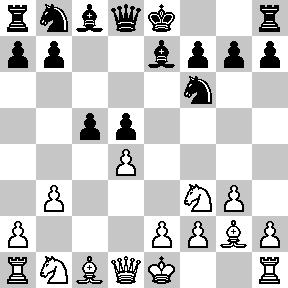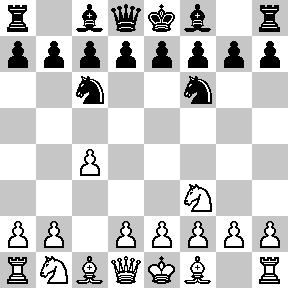Recipe for the Reti
Although I was well aware of its existence and even had a certain detached respect for the bloody opening, before last week I had never run into the Reti over the board. Then along came an opponent who quickly rattled off 1.Nf3 d5 2.c4 and I sat scratching my head. I knew that black could play 2...d4, but that looked horribly committal and 2...dxc4 would likewise lose time and run into a flood of tactics. Deciding that I should swallow my pride and play conservatively, I chose 2...e6 and the game continued 3.g3 Nf6 4.Bg2 Be7 5.b3 c5 6.cxd5 exd5 7.d4 and I was faced with the ugly decision of choosing between a pair of weak hanging pawns - after 7...b6 - or an isolated queen-pawn. I chose the former evil, judging it to be lesser, and promptly found myself in a positional disaster that crashed and burned in about 30 moves. Afterwards I quickly determined that I should have played 6...Nxd5 and veered toward a solid QID type structure, but needless to say, I don't play the Queen's Indian and I was not prepared for this transposition.
I chose the former evil, judging it to be lesser, and promptly found myself in a positional disaster that crashed and burned in about 30 moves. Afterwards I quickly determined that I should have played 6...Nxd5 and veered toward a solid QID type structure, but needless to say, I don't play the Queen's Indian and I was not prepared for this transposition.
So I went home and poured over the pages of the books that I have that cover the Reti, looking over all of the alternative lines. The opening is not exactly mainstream and it really seemed to me that black should have a wealth of good resources, but I didn't find them. Line after line seemed uncomfortable for black, as white consistently reserved his two central pawns for powerful breaks at the optimum moment. I didn't like 1.Nf3 d5 2.c4 dxc4 3.e4 and I was not convinced by the accepted lines stemming from 1.Nf3 d5 2.c4 e6 3.g3 Nf6 4.Bg2 dxc4. It seemed like a lot of pressure to absorb to snatch a pawn that black wouldn't even get to keep.
I kept at it though, tearing through the lines looking for an improvement or an unbalancing line with good practical chances. Then finally it struck me - why not simply force a transposition to an e5 English? How? Well, play Nf6 and then Nc6!? It seemed so weird that it might be dubious, so I checked out chessbase and found that it had been played plenty of times, but almost never by a master... and most of the games were not well executed. The genesis of the idea comes from the Tango lines, 1.d4 Nf6 2.c4 Nc6 3.Nf3 e6 and in fact, this exact position can arise from the Reti move-order after 1.Nf3 Nf6 2.c4 Nc6 3.d4. More probable though, I thought was something like 1.Nf3 Nf6 2.c4 Nc6 3.g3 e5, after which 4.Nc3 Bb4 and 4.d4 e4/exd4 are main lines from the e5 English. These e5 lines are rich with tactics that stem from Sicilian-like lines, perfect for upsetting the equilibrium of a well-seasoned Reti player, but even more importantly, no matter how white replied, the game would quickly leave the pages of mainline Reti theory. I've looked at it and looked at it, run my Fritz checks, and there is nothing wrong with the line, so the only question is - why don't the masters play it?
It seemed so weird that it might be dubious, so I checked out chessbase and found that it had been played plenty of times, but almost never by a master... and most of the games were not well executed. The genesis of the idea comes from the Tango lines, 1.d4 Nf6 2.c4 Nc6 3.Nf3 e6 and in fact, this exact position can arise from the Reti move-order after 1.Nf3 Nf6 2.c4 Nc6 3.d4. More probable though, I thought was something like 1.Nf3 Nf6 2.c4 Nc6 3.g3 e5, after which 4.Nc3 Bb4 and 4.d4 e4/exd4 are main lines from the e5 English. These e5 lines are rich with tactics that stem from Sicilian-like lines, perfect for upsetting the equilibrium of a well-seasoned Reti player, but even more importantly, no matter how white replied, the game would quickly leave the pages of mainline Reti theory. I've looked at it and looked at it, run my Fritz checks, and there is nothing wrong with the line, so the only question is - why don't the masters play it?
 I chose the former evil, judging it to be lesser, and promptly found myself in a positional disaster that crashed and burned in about 30 moves. Afterwards I quickly determined that I should have played 6...Nxd5 and veered toward a solid QID type structure, but needless to say, I don't play the Queen's Indian and I was not prepared for this transposition.
I chose the former evil, judging it to be lesser, and promptly found myself in a positional disaster that crashed and burned in about 30 moves. Afterwards I quickly determined that I should have played 6...Nxd5 and veered toward a solid QID type structure, but needless to say, I don't play the Queen's Indian and I was not prepared for this transposition.So I went home and poured over the pages of the books that I have that cover the Reti, looking over all of the alternative lines. The opening is not exactly mainstream and it really seemed to me that black should have a wealth of good resources, but I didn't find them. Line after line seemed uncomfortable for black, as white consistently reserved his two central pawns for powerful breaks at the optimum moment. I didn't like 1.Nf3 d5 2.c4 dxc4 3.e4 and I was not convinced by the accepted lines stemming from 1.Nf3 d5 2.c4 e6 3.g3 Nf6 4.Bg2 dxc4. It seemed like a lot of pressure to absorb to snatch a pawn that black wouldn't even get to keep.
I kept at it though, tearing through the lines looking for an improvement or an unbalancing line with good practical chances. Then finally it struck me - why not simply force a transposition to an e5 English? How? Well, play Nf6 and then Nc6!?
 It seemed so weird that it might be dubious, so I checked out chessbase and found that it had been played plenty of times, but almost never by a master... and most of the games were not well executed. The genesis of the idea comes from the Tango lines, 1.d4 Nf6 2.c4 Nc6 3.Nf3 e6 and in fact, this exact position can arise from the Reti move-order after 1.Nf3 Nf6 2.c4 Nc6 3.d4. More probable though, I thought was something like 1.Nf3 Nf6 2.c4 Nc6 3.g3 e5, after which 4.Nc3 Bb4 and 4.d4 e4/exd4 are main lines from the e5 English. These e5 lines are rich with tactics that stem from Sicilian-like lines, perfect for upsetting the equilibrium of a well-seasoned Reti player, but even more importantly, no matter how white replied, the game would quickly leave the pages of mainline Reti theory. I've looked at it and looked at it, run my Fritz checks, and there is nothing wrong with the line, so the only question is - why don't the masters play it?
It seemed so weird that it might be dubious, so I checked out chessbase and found that it had been played plenty of times, but almost never by a master... and most of the games were not well executed. The genesis of the idea comes from the Tango lines, 1.d4 Nf6 2.c4 Nc6 3.Nf3 e6 and in fact, this exact position can arise from the Reti move-order after 1.Nf3 Nf6 2.c4 Nc6 3.d4. More probable though, I thought was something like 1.Nf3 Nf6 2.c4 Nc6 3.g3 e5, after which 4.Nc3 Bb4 and 4.d4 e4/exd4 are main lines from the e5 English. These e5 lines are rich with tactics that stem from Sicilian-like lines, perfect for upsetting the equilibrium of a well-seasoned Reti player, but even more importantly, no matter how white replied, the game would quickly leave the pages of mainline Reti theory. I've looked at it and looked at it, run my Fritz checks, and there is nothing wrong with the line, so the only question is - why don't the masters play it?
